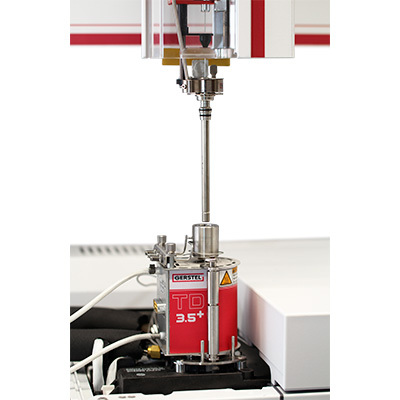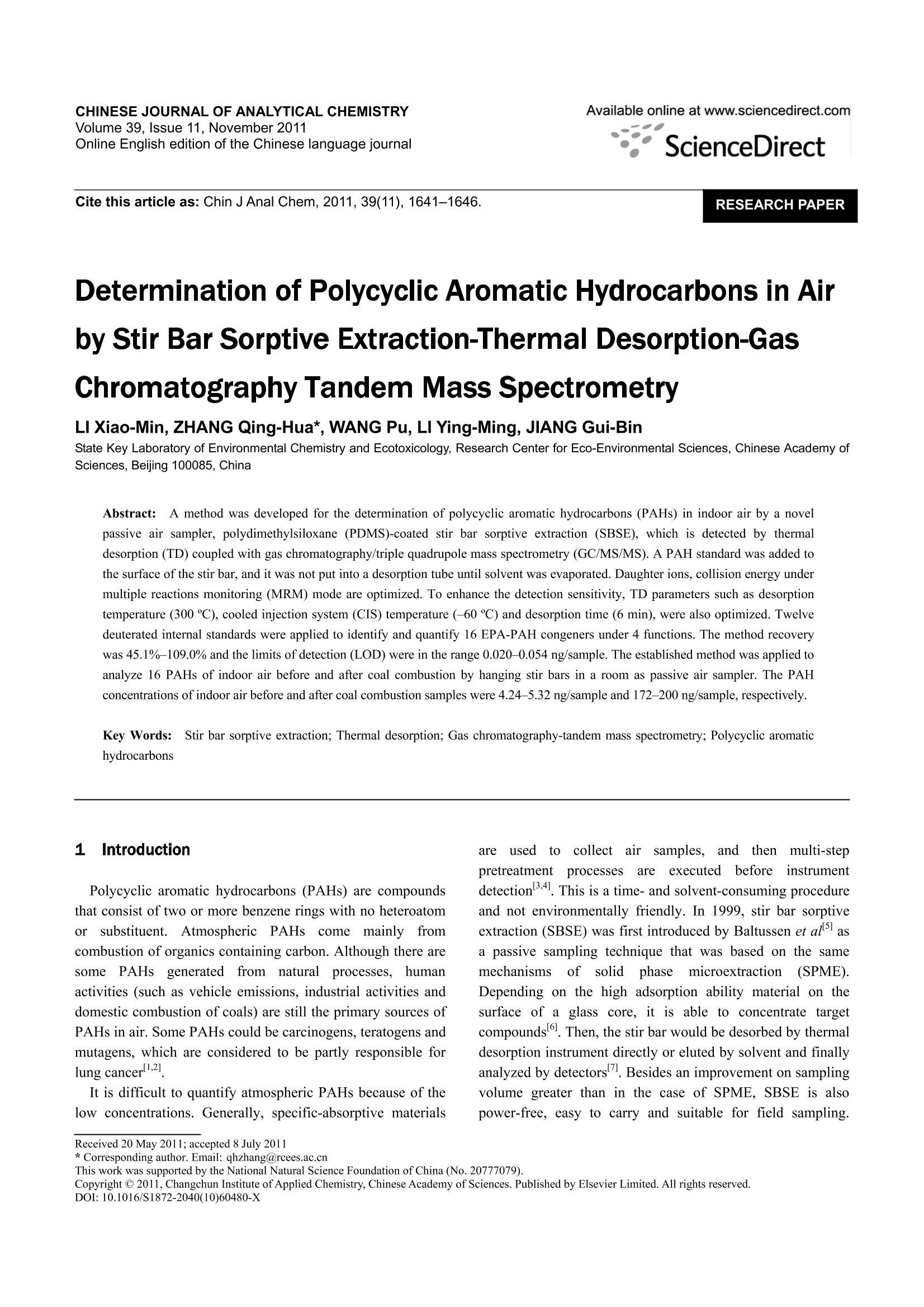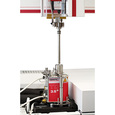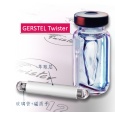
方案详情
文
与传统检测空气中的多环芳烃方法相比, 采用SBSE被动采样技术, 大大减少了采样时间,仅需3小时就能达到传统方法3天的检测下限,并且无须溶剂,直接采取热脱附进样,绿色环保,成本低,携带方便,方法成熟。
方案详情

Available online at www.sciencedirect.comCHINESE JOURNAL OF ANALYTICAL CHEMISTRYVolume 39, Issue 11, November 2011Online English edition of the Chinese language journalScienceDirectCite this article as: Chin J Anal Chem, 2011, 39(11),1641-1646.RESEARCH PAPER LI Xiao-Min et al./Chinese Journal of Analytical Chemistry,2011,39(11):1641-1646 Determination of Polycyclic Aromatic Hydrocarbons in Airby Stir Bar Sorptive Extraction-Thermal Desorption-GasChromatography Tandem Mass Spectrometry LI Xiao-Min, ZHANG Qing-Hua*, WANG Pu, LI Ying-Ming, JIANG Gui-Bin State Key Laboratory of Environmental Chemistry and Ecotoxicology, Research Center for Eco-Environmental Sciences, Chinese Academy ofSciences, Beijing 100085, China Abstract:A method was developed for the determination of polycyclic aromatic hydrocarbons (PAHs) in indoor air by a novelpassive air sampler, polydimethylsiloxane (PDMS)-coated stir bar sorptive extraction (SBSE), which is detected by thermaldesorption (TD) coupled with gas chromatography/triple quadrupole mass spectrometry (GC/MS/MS). A PAH standard was added tothe surface of the stir bar, and it was not put into a desorption tube until solvent was evaporated. Daughter ions, collision energy undermultiple reactions monitoring (MRM) mode are optimized. To enhance the detection sensitivity, TD parameters such as desorptiontemperature (300℃), cooled injection system (CIS) temperature (-60℃) and desorption time (6 min), were also optimized. Twelvedeuterated internal standards were applied to identify and quantify 16 EPA-PAH congeners under 4 functions. The method recoverywas 45.1%-109.0% and the limits of detection (LOD) were in the range 0.020-0.054 ng/sample. The established method was applied toanalyze 16 PAHs of indoor air before and after coal combustion by hanging stir bars in a room as passive air sampler. The PAHconcentrations of indoor air before and after coal combustion samples were 4.24-5.32 ng/sample and 172-200 ng/sample, respectively. Key Words::S9tir bar sorptive extraction; Thermal desorption; Gas chromatography-tandem mass spectrometry; Polycyclic aromatichydrocarbons 1 Introduction Polycyclic aromatic hydrocarbons (PAHs) are compoundsthat consist of two or more benzene rings with no heteroatomorsubstituent. AtmosphericPAHscome mainly fromcombustion of organics containing carbon. Although there aresome PAHsgeneratedffrom natural processes, humanactivities (such as vehicle emissions, industrial activities anddomestic combustion of coals) are still the primary sources ofPAHs in air. Some PAHs could be carcinogens, teratogens andmutagens, which are considered to be partly responsible forlung cancer. It is difficult to quantify atmospheric PAHs because of thelow concentrations. Generally, specific-absorptive materials are used tocollect air samples,.anddthenmulti-steppretreatment processes areeexecuted bbeforeinstrumentdetection3.41.This is a time- and solvent-consuming procedureand not environmentally friendly. In 1999, stir bar sorptiveextraction (SBSE) was first introduced by Baltussen et alasa passive sampling technique that was based on the samemechanismsof:solidphase microextractionn ((SPME).Depending on the high adsorption ability material on thesurface of a glass core, it is able to concentrate targetcompounds. Then, the stir bar would be desorbed by thermaldesorption instrument directly or eluted by solvent and finallyanalyzed by detectors. Besides an improvement on samplingvolume greater than in the case of SPME, SBSE is alsopower-free, easy to carry and suitable for field sampling. ( R eceived 20 May 2011; a c cepted 8 July 2011 ) ( * Corresponding author. Email: qhzhang@rcees.ac.cn ) ( This work was supported by the National Natural Science Fo u ndation of China (No. 207 7 7079). ) ( Copyright C 2011, Changchun Institute of Applied Chemistry, Chinese Academy of Sciences. Publi s hed by Elsevie r Limited. All rights reserved. ) ( DOI: 1 0.1016/S1872-2040(10)60480-X ) Another advantage is that no pretreatment is needed during thewhole process.:NNow SBSEEisSmainlvyuseddto extractcompounds from liquid samples8-11] and is rarely applied todetermine the concentration of volatile/semi-volatilecompounds in air 2.13]. Henkelmann et al l4] did a preliminaryresearch using SBSE as a passive air sampler, but the recoveryof high-ring PAHs was relatively low. In this study, based onSBSE coupled with thermal desorption (TD)-GC/MS/MS, amethod was established by using deuterated internal standardsto identify and quantify 16 EPA-PAHs in air. The method hasbeen applied for the quantitative analysis of PAHs before andafter coal combustion in indoor air. 2 Experimental 2.1 Instruments and materlals Athermalalddesorption unit coupledd toan MPS2auto-sampler was purchased from Gerstel (Miilheim an derRuhr, Germany). Waters Micromass Quattro micro GC (USA)was equipped with a capillary column of DB-5MS (30 m x250 um i.d. ×0.25 um film). Twister stir bars (stir bar sorptive extraction, SBSE, 20 mmx0.5 mm, Gerstel, Mulheim an der Ruhr, Germany) werepre-cleaned at 320℃ (under a helium stream of 50 mL min )in an empty glass tube for 3 h before use. The bars were thensealed in a GC vial when they cooled down. A standard mixture, EPA M-610, containing 16 EPA-PAHs(naphthalene, acenaphthylene, acenaphthene, fluorene.phenanthrene, anthracene, fluoranthene, pyrene, benzo(a)-anthracene. chrysene, benzo(b)fluoranthene, benzo(k)-fluoranthene. benzo(a)pyrene, indeno(1,2,3,c-d)pyrene,dibenz(a,h)anthracene and benzo(ghi)perylene) was purchasedfrom Accustandard (USA). An internal standard (IS) mixturecontaining i2 deuterated PAHs (d8-naphthalene,d8-acenaphthylene, d10-phenanthrene, d10-fluoranthene, 12-benzo(a)anthracene, d12-chrysene,d12-benzo(b)fluoranthene,d12-benzo(k)fluoranthene, d12-benzo(a)pyrene, d12-indeno-(1,2,3,c-d)pyrene, d14-dibenz(a,h)anthracene, d12-benzo(ghi)-perylene and L429-IS) was purchased from Wellington (Canada). 2.2 GC/MS/MS conditions for PAHs analysis The GC was operated in a splitless mode with an inlettemperature of 280 ℃ and a transferline temperature of 300℃.The system was covered under a gas flow of He (e99.999%).After 5.5 min, solvent delay finished, and the GC oven programbegan at 50℃. After holding this temperature for 2 min, it wasramped to 200 ℃ at 19℃ min, held for 2 min, then ramped to240℃ at 4.5℃ min and held for 2 min. Finally, thetemperature of oven reached 290 ℃ at 2.5℃ min,which wasmaintained for 2 min to reach an analysis time of 44.7 min. The samples were analyzed by a Quattro micro GC tandem quadrupole mass spectrometer operated in electron impact(EI") ionization mode. The ion source was operated at 200 ℃with an electron energy of 70 eV, a trap current of 200 pA anda repeller of 9.4 V. LM resolution 1, HM resolution 1, ionenergy, LM resolution 2, HM resolution 2, ion energy 2 andmultiplier were respectively set to 4.0, 14.3,0.8,8.3, 14.4, 1.0and 650. 2.3 Optimization of PAH detection in MRM mode The product ions of selected PAHs were monitored indaughter scan mode, the strongest of which was chosen to bethe transition of that molecular ion. In multiple reaction monitoring (MRM) mode, the collisionenergies of both native and deuterated PAHs were optimizedby setting a graded collision energy for each compound whilethe other parameters were fixed 5. The biggest peak arearelated collisionenergy would be finally selected.16EPA-PAHs and 12 deuterated PAHs and their associatedorders of peaks, names, retention time, transitions, collisionenergy and relationships are listed in Table 1. 2.4 Sampling procedure Every stir bar was conditioned before use. Both native anddeuterated standard solutions with specified volume andconcentration were spiked on the surface of the stir bar. Afterthe solvent was evaporated, the stir bar was inserted into aglass tube, and then desorbed and detected by TD-GC/MS/MS. The travel blank samples were obtained by taking the GCvials which held stir bars to the sampling room. The vialswere closed immediately after a quick open and carefully keptuntil analysis. During a real sampling process, the stir bar wastaken out by tweezers from the GC vial, hung and exposed inair. The stir bar was fastened by clamping its glass terminalwith a lab-made iron clip. House background samples wereobtained by hanging 3 stir bars in the room for 2 h before coalcombustion. Coal combustion samples were obtained byhanging 3 stir bars in the room for 2 h when coal combustionwas stable. 3 Result and discussion 3.1 Optimization of TD operation condition Desorption temperature, cooled injection system (CIS)temperature and desorption time of 16 EPA-PAHs areoptimizedby comparingeach compound's individualchromatogram peak area. 3.1.1 Desorption temperature There is a great difference between low- and high-ring Table 1MRM transitions, retention time and collision energy for 16 PAHs and 12 duterated-PAHs Polycyclic aromatic hydrocarbon Retention MRM Collision IS retention MRM Collision Function time (min) (m/z) enegy (eV) Deuterated PAHs time (min) (m/z) enegy (eV) 1 Naphthalene 1 8.67 128>128 15 dg-Naphthalene 8.64 136>136 10 2 Acenaphthylene 1 10.78 152>151 20 dg-Acenaphthylene 10.74 160>158 20 3 Acenaphthene 1 11.05 154>153 20 dg-Acenaphthylene 4 Fluorene 2 11.98 166>165 20 dio-Phenanthrene 5 Phenanthrene 2 14.35 178>151 40 dio-Phenanthrene 14.28 188>160 20 6 Anthracene 2 14.51 178>151 40 dio-Phenanthrene 7 Fluoranthene 3 18.55 202>202 20 dio-Fluoranthene 18.48 212>212 10 8 Pyrene 3 19.46 202>202 20 dio-Fluoranthene 9 Benzo(a)anthracene 3 25.83 228>226 30 d12-Benzo(a)anthracene 25.68 240>236 30 10 Chrysene 3 26.04 228>226 30 d12-Chrysene 25.88 240>236 30 11 Benzo(b)fluoranthene 4 33.05 252>250 30 d12-Benzo(b)fluoranthene 32.90 264>260 30 12 Benzo(k)fluoranthene 4 33.23 252>250 30 d12-Benzo(k)fluoranthene 33.11 264>260 30 13 Benzo(a)pyrene 4 35.19 252>250 30 d12-Benzo(a)pyrene 35.02 264>260 30 14 Indeno(1,2,3,c-d)pyrene 4 42.52 276>274 40 di2-Indeno(1,2,3,c-d)pyrene 42.37 288>284 40 15 Dibenz(a,h)anthracene 4 42.87 278>276 35 d14-Dibenz(a,h)anthracene 42.68 292>288 35 16 Benzo(ghi)perylene 4 44.09 276>274 40 d12-Benzo(ghi)perylene 43.91 288>284 40 PAHs when considering the desorption temperature. Highertemperature is needed for high-ring PAHs because of their lowvolatility. It has been reported that the desorption temperaturefor PAHs is usually higher than 280 ℃16-181. However, thePDMS coating of stir bar itself is limited to 300 C. So thedesorption temperature at 280℃ and that at 300 ℃ werecompared. The peak area obtained at 300 ℃ was 1.0-3.0times more than that at 280 C, and thus, 300 ℃ was selectedin the rest of the experiments. 3.1.2 CIS temperature Cooled injection system (CIS) temperature is a criticalfactor that could affect desorption efficiency. However,affected by their boiling points, high-ring PAHs performeddifferently on trapping and desorption efficiency fromlow-ring PAHs at the same temperature. To opitimize thetrapping system, we selected five points (-80,-60,-40,-20, 0and 20 ℃) to study the optimal temperature. The resultsshowed that low-ring PAHs would be better trapped in CIS atlow temperatures. As the temperature increased (-20,0 and 20℃),signals of high-ring PAHs decreased. In contrast, 4- and 5-ring PAHs showed better results when CIS temperature was higher.There was only little variance for 6-ring PAHss whentemperature changed (Fig.1). Finally, -60 ℃ was selected forthe rest of the experiments. 3.1.3 'DDesorption time The desorption efficiencyy would be affected if thedesorption time is not long enough. Normally 6 min ischosen for PAHs7. In this study, desorption times of 4, 6and 8 min were tested under the fixed CIS temperature (-60℃), desorption flow (50 mL min) and the desorptiontemperature (300℃). The results showed that the desorptionefficiency at 4 min took 68.9% of that obtained at 6 min.Similar chromatography peak areas were observed at 6 and 8min, which showed that 6 min was enough for desorption(Fig.2). 3.2 Chromatographic separation As can be seen from Fig.3, 16 EPA-PAHs have been wellseparated. Fig.1 Influence of CIS temperature on PAH detection 3.3 Standard curve 0.06, 0.3, 0.9, 1.8 and 3.6 ng native standard and 1 ng ISstandard were evenly spiked on 5 conditioned stir barsseparately. The stir bar was put into a desorption tube anddetected under optimized conditions. Standard curve wasmade by detecting 5 stir bars in a sequence. The correlationcoefficients of 16 PAHs were higher than 0.97 (Table 2),which showed good linearity. 3.4 Limit of detection and recovery Limit of detection (LOD) is defined as 3 times signal-to-noise ratio (S/N). LOD for blank samples were in the range0.020-0.054 ng/sample. Recovery was calculated by spiking0.9 ng native standard on the surface of 3 stir bars separately(Table 2). The results showed that 16 PAHs recoveries werebetween 45.1%-109.0%(n=3). 3.5 Air sampling before and after coal combustion 216PAHsinintravel blank samples, house background samples and coal combustion samples were in the range0.65-1.60 ng per sample, 4.24-5.32 ng per sample and172-200 ng per sample, respectively. The RSD of combustionsamples were in the range 4.8%-35.1%.Z16PAHs in travelblank samples were only 0.6% of that of coal combustionsamples, so the background of stir bar could be neglected.Average contents of naphthalene, acenaphthylene, acenaph-thene, fluorene, phenanthrene, anthracene,fluoranthene,pyrene, benzo(a)anthracene, chrysene, benzo(b)fluoranthene,benzo(k)fluoranthene,benzo(a)pyreneebeforee combustionwere much higher than blank sample, especially for thelow-ring PAHs. This might be due to that low-ring PAHs aremore volatile and tend to exist in gas phase, which could beeasily absorbed on the PDMS surface. However, the high-ringPAHs were inclined to be absorbed on the particles, which tookmore time to reach absorption balance. Z16PAHs of indoor airobviously increased during the coal combustion process. The 16 individual PAHs in coal combustion samples were4.7-376 times more than those of house background samples.In particular, the value of benzo(a)pyrene increased 20.3 timesduring the coal combustion (Fig.4), which indicated that alarge amount of PAHs were generated during combustion. Fig.3(Chromatogram of 16 PAHs (0.9 ng) under multiple reaction monitoring mode 1, Naphthalene; 2, Acenaphthylene; 3, Acenaphthene; 4, Fluorene; 5, Phenanthrene; 6, Anthracene; 7, Fluoranthene; 8, Pyrene; 9, Benzo(a)anthracene; 10, Chrysene;11, Benzo(b)fluoranthene; 12, Benzo(k)fluoranthene; 13, Benzo(a)pyrene; 14, Indeno(1,2,3,c-d)pyrene; 15, Dibenz(a,h)anthracene; 16, Benzo(ghi)perylene Table 2 Correlation coefficient, LOD and recovery of PAHs PAHs Correlation coefficient LOD Recovery (%) (ng/sample) S1 S2 S3 RSD Naphthalene 0.990 0.054 63.8 65.0 47.9 16.2 Acenaphthylene 0.995 0.022 106 102 77.2 16.4 Acenaphthene 0.994 0.022 88.8 87.9 68.1 14.3 Fluorene 0.997 0.028 82.3 78.5 66.4 11.0 Phenanthrene 0.995 0.032 81.4 77.1 60.5 15.1 Anthracene 0.995 0.020 91.4 88.4 70.5 13.5 Fluoranthene 0.996 0.025 104 100 71.4 19.4 Pyrene 0.995 0.026 109 107 72.7 21.2 Benzo(a)anthracene 0.988 0.027 66.5 72.2 54.1 14.4 Chrysene 0.990 0.030 67.9 75.2 55.9 14.7 Benzo(b)fluoranthene 0.987 0.033 69.8 72.6 58.5 11.1 Benzo(k)fluoranthene 0.986 0.033 69.4 71.7 53.3 15.5 Benzo(a)pyrene 0.984 0.032 69.7 70.7 56.6 12.0 Indeno(1,2,3,c-d)pyrene 0.975 0.034 63.8 74.6 56.8 13.8 Dibenz(a,h)anthracene 0.975 0.034 52.7 64.3 49.4 14.1 Benzo(ghi)perylene 0.972 0.041 55.4 66.6 45.1 19.3 In this study, we developed a passive air sampling methodbased on SBSE-TD-GC/MS/MS to identify and quantifyair-phase PAHs. It is a solvent-free method to detect air-phasePAHs because no pretreatment is needed during the wholeanalysis process. Meanwhile, high analytical sensitivity and reliable linearity are obtained in MRM mode. This method isfurther applied to detect indoor atmospheric PAHs levels beforeand after coal combustion. The result implies that PAHs aregenerated during the coal combustion process. The establishedmethod could enable quick, sensitive detection of air-phasePAHs. However, a further study about the sampling volume ofstir bars should be made to determine air concentrations of PAHs. Fig.4 PAHs concentrations of travel blank, house background and coal buning (ng) ( [1] Baek S O, F ield R A, Goldstone M E, K irk P W, Lester J N, Perry R. W ater; Air; Soil Pollut.,1991,60(3): 279-300 ) ( [2] deMarini D M, Landi S, Tian D , Hanley N M , Li X , H u F, Roop B C, Mass M J, K e ohavong P, G a o W, Olivier M, Hainaut P, Mumford J L . Cancer Res., 2001, 61(18): ) ( 6679-6681 ) Fan S X, Huang H L, Gu K H, Li H S, Zhu B, Zhang H L,Fan Y. Chem. J. Chinese Universities, 2010, 31(12):2375-2382 [4] Poster D L, Schantz M M, Sander L C, Wise S A. Anal.Bioanal. Chem.,2006,386(4):859-881 5] Baltussen E, Sandra P, David F, Cramers C. J. MicrocolumnSep., 1999, 11(10): 737-747 ( [6] J i X J, Yang C G,L a n X Z. Ch i nese J. An a l. Ch e m., 2008,36(12):1641 - 1645 ) ( [7] Yu C H, Hu Bin, Jiang Z C. C h inese J. A n al. C h em., 2 0 06,34(Suppl.): S289-S294 ) ( [81 Montero L, Popp P, P a schke A, Pa w liszyn J. J. Chromatogr. A,2004, 1 025(1):17-26 ) ( [9] Prieto A, Zuloaga O, U sobiaga A, Etxebarria N, Fernandez L A. J. Chromatogr: A, 2007. 1174(1-2): 40-49 ) ( [10] Qu G L, L iu G H,Ma G H, Li F R . Chinese J. Anal. Chem., 2007,35(8):1215 - 1217 ) ( [1 1] Caven-Quantrill D J , B uglass A J. J. Chromatogr A , 2 0 11,1218(7):875-881 ) ( [12] Demeestere K , D ewulf J, de W itte B, van Langenhove H. J.Chromatogr: A, 2007,1153(1-2):130-144 ) ( [13] David F , Sandra P.J. Chromatogr 4, 2007, 1152(1-2):54 - 69 ) ( [14] Henkelmann B , B arka A, Schramm K W . Organohalogen Compounds, 2007,69:718-721 ) ( [15] Worrall K. Environmental Chemistry,2008,27(2): 278-279 ) ( [16] Kolahgar B, H offmann A, H e iden A C. J. C h romatogr: A, 2002,963(1-2):225-230 ) ( [17] León V M, A l varez B , C o bollo M A, Mu n oz S, Val o r I. J. Chromatogr. A, 2003,999(1-2):91- 1 01 ) ( [18] Perez-Carrera E, Leon V M , Parra A G. Gonzalez-Mazo E. J.Chromatogr. A,2007, 1 1 70(1-2):82 - 90 ) 多环芳烃(PAHs) 是由两个或两个以上不含杂原子和取代基的苯环构成的一类化合物。大气中PAHs主要来源于含碳有机质的燃烧, 虽然自然条件下也生成部分PAHs,但人类活动仍然是大气中PAHs 的主要来源,包括机动车尾气排放、工业活动和燃煤取暖等过程。部分PAHs 具有致癌、致畸及致突变性,是肺癌发病的重要诱因。大气中PAHs含量很低,一般为痕量、超痕量水平。大气中PAHs的检测一般利用对其有吸附性能的材料进行吸附采样,在样品进行仪器检测前需较复杂的前处理过程。前处理过程耗时,且消耗大量溶剂,容易对环境造成污染。搅拌棒吸附萃取技术( Stir bar sorptive extraction, SBSE) 是在固相微萃取(SPME) 基础上发展起来的一种新型采样技术,它利用玻璃棒表面涂渍的高吸附性能材料对环境介质中目标化合物进行吸附,利用与检测仪器直接相连接的热解析仪器进行脱附、检测或通过溶剂对搅拌子洗脱后进样。与SPME相比,SBSE 涂层体积比较大,且兼具采样无需动力、体积微小、方便携带、无需前处理过程等优点,适于野外采样......"PDMS搅拌子有10mm,20mm两种长度,各有标准和加厚的吸附层,共四种类型可供选择。使用热脱附设备,热解吸PDMS搅拌子目标分析物:16种美国环境保护署EPA优先PAHs实验条件优化脱附温度: 300 ℃冷阱温度: - 60 ℃脱附时间: 6 min标准曲线: 将含有5个量级的PAHs外标溶液(0.06,0.3,0.9,1.8和3.6 ng)和含有1 ng内标的内标溶液分别均匀涂抹于5 个老化好的搅拌子表面,待溶剂挥发后,立即将其放置于脱附管中,按照优化的实验条件进行分析检测,制作标准曲线。16 种PAH标准曲线的线性回归系数r均大于0.97,线性关系良好。燃煤前后室内空气中PAHs 采样烧煤前后空气采样现场,三个PDMS搅拌子被悬挂在空中进行被动采样烧煤前后空气中多环芳烃水平的变化“旅行空白样品、室内背景样品及燃煤后采集样品中16 种PAHs含量分别在0.653-1.60 ng、4.24-5.32 ng、172-200 ng之间,实际样品RSD在4.8 %-35.1%之间。在燃煤过程中,室内大气中PAHs含量明显上升。燃煤后,室内大气的PAHs单体平均值是燃煤前的4.7-376 倍,其中Bap是室内背景值的20.3 倍(见下图) ,说明燃煤过程中有大量多环芳烃生成。”与传统方法相比, 采用SBSE被动采样技术, 大大减少了采样时间,仅需3小时就能达到传统方法3天的检测下限,并且无须溶剂,直接采取热脱附进样,绿色环保,成本低,携带方便,方法成熟。 以上内容主要摘取自:李晓敏、张庆华、王璞、李英明、江桂斌,搅拌子固相吸附-热脱附-气相色谱/ 质谱/ 质谱法快速测定空气中多环芳烃,Chinese Journal of Analytical Chemistry,2011,39. DOI : 10.3724/ SP. J.1096.2011.01641
确定






还剩4页未读,是否继续阅读?
GERSTEL(哲斯泰)为您提供《空气中多环芳烃检测方案(热解吸仪)》,该方案主要用于空气中有机污染物检测,参考标准--,《空气中多环芳烃检测方案(热解吸仪)》用到的仪器有GERSTEL热脱附仪TD3.5+ (热解吸,热解析)、GERSTEL 搅拌棒Twister (萃取、固相微萃取)、GERSTEL自动进样器 MPS robotic
相关方案
更多
该厂商其他方案
更多











